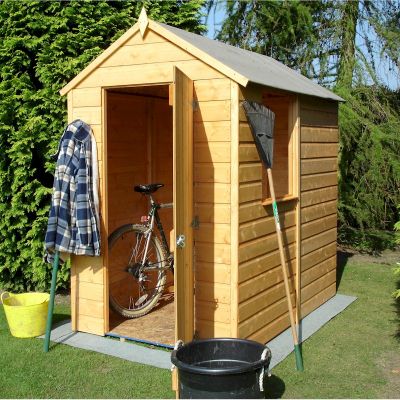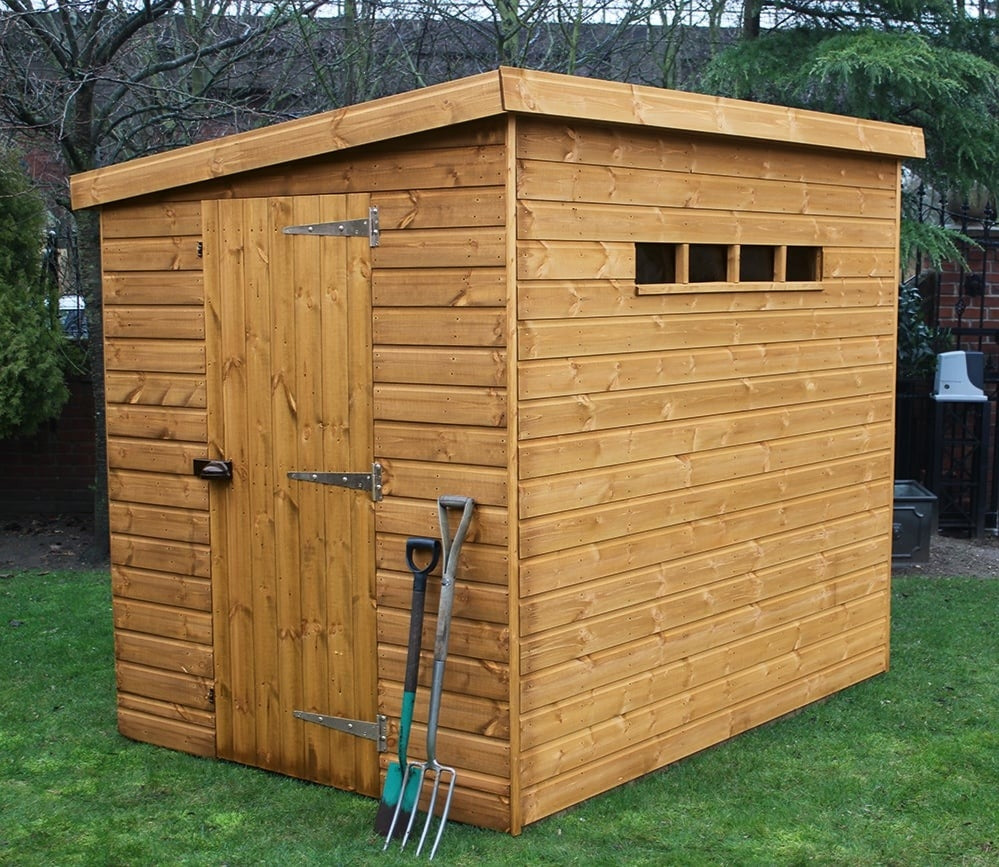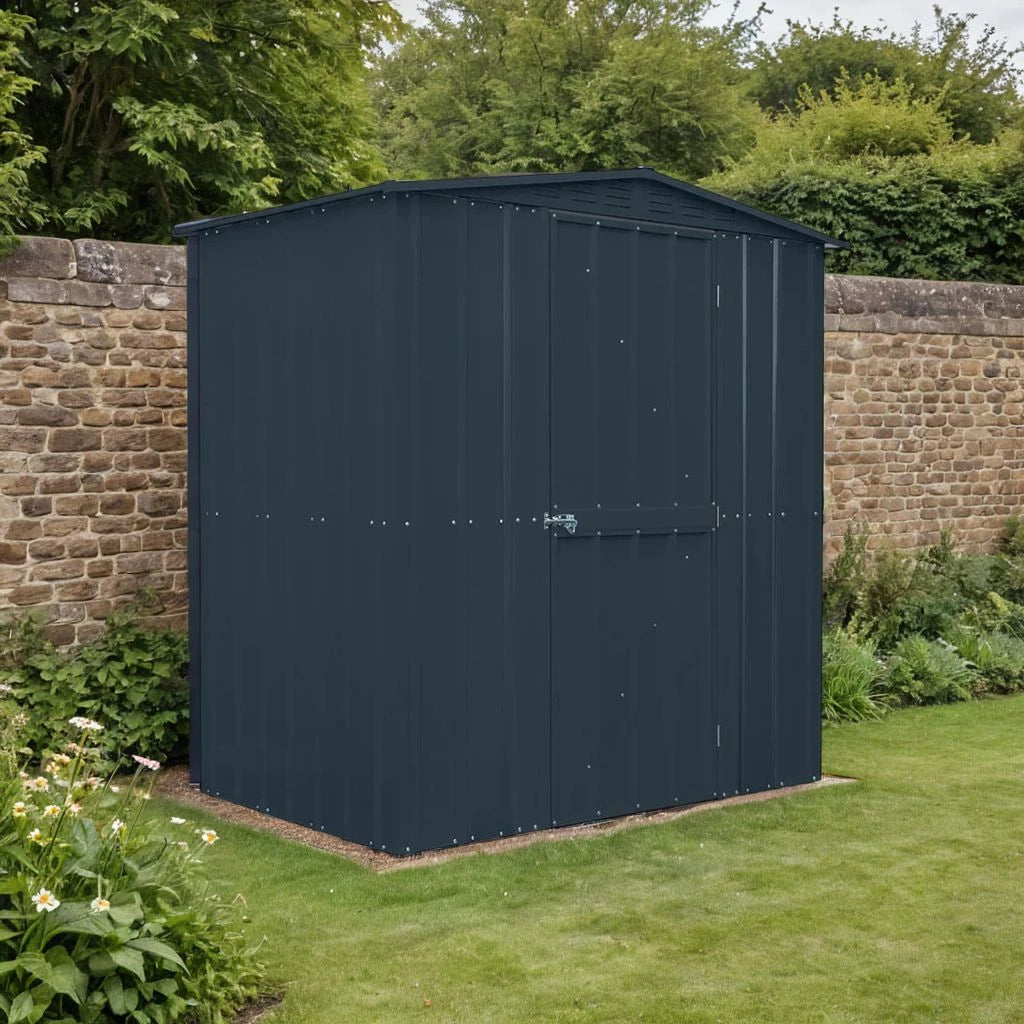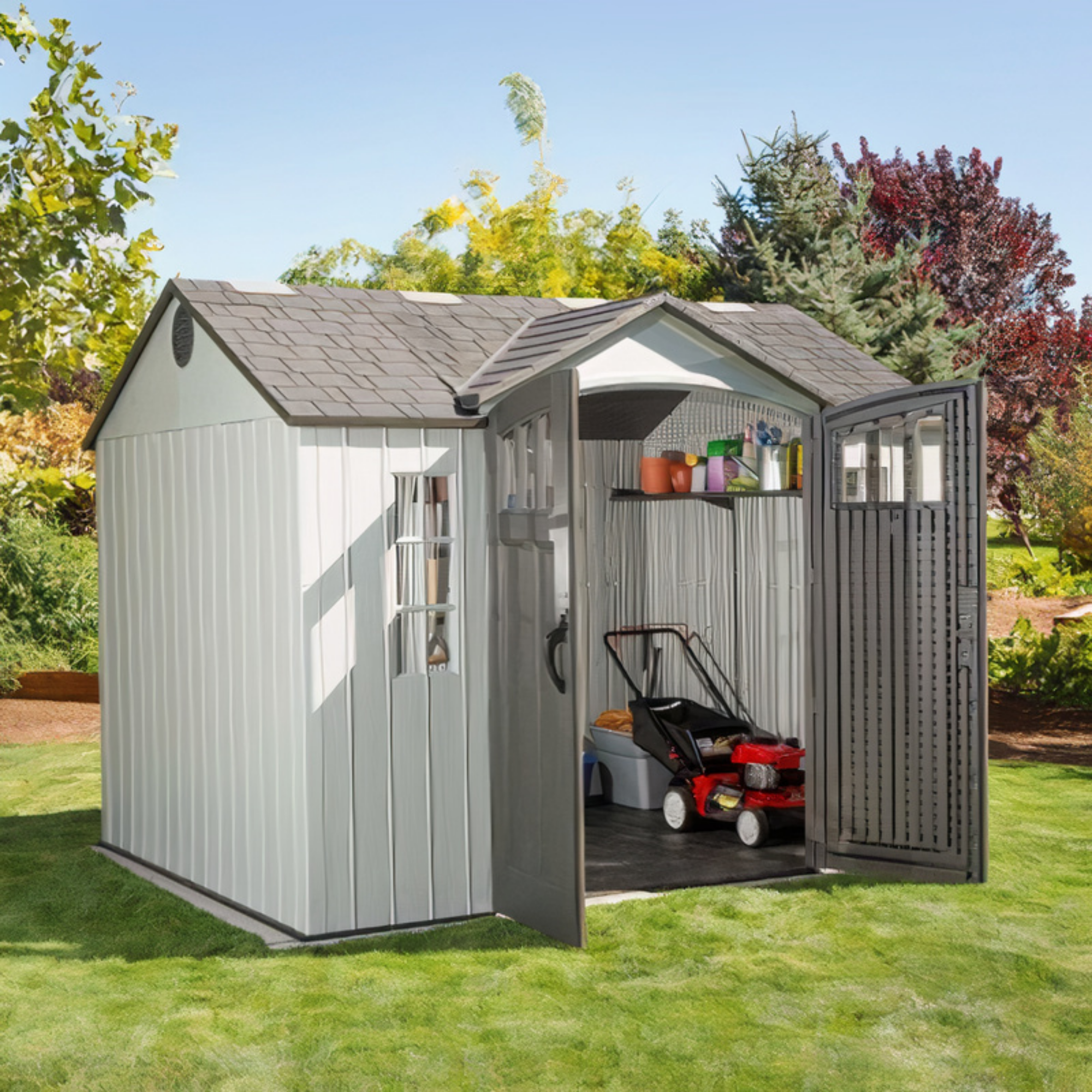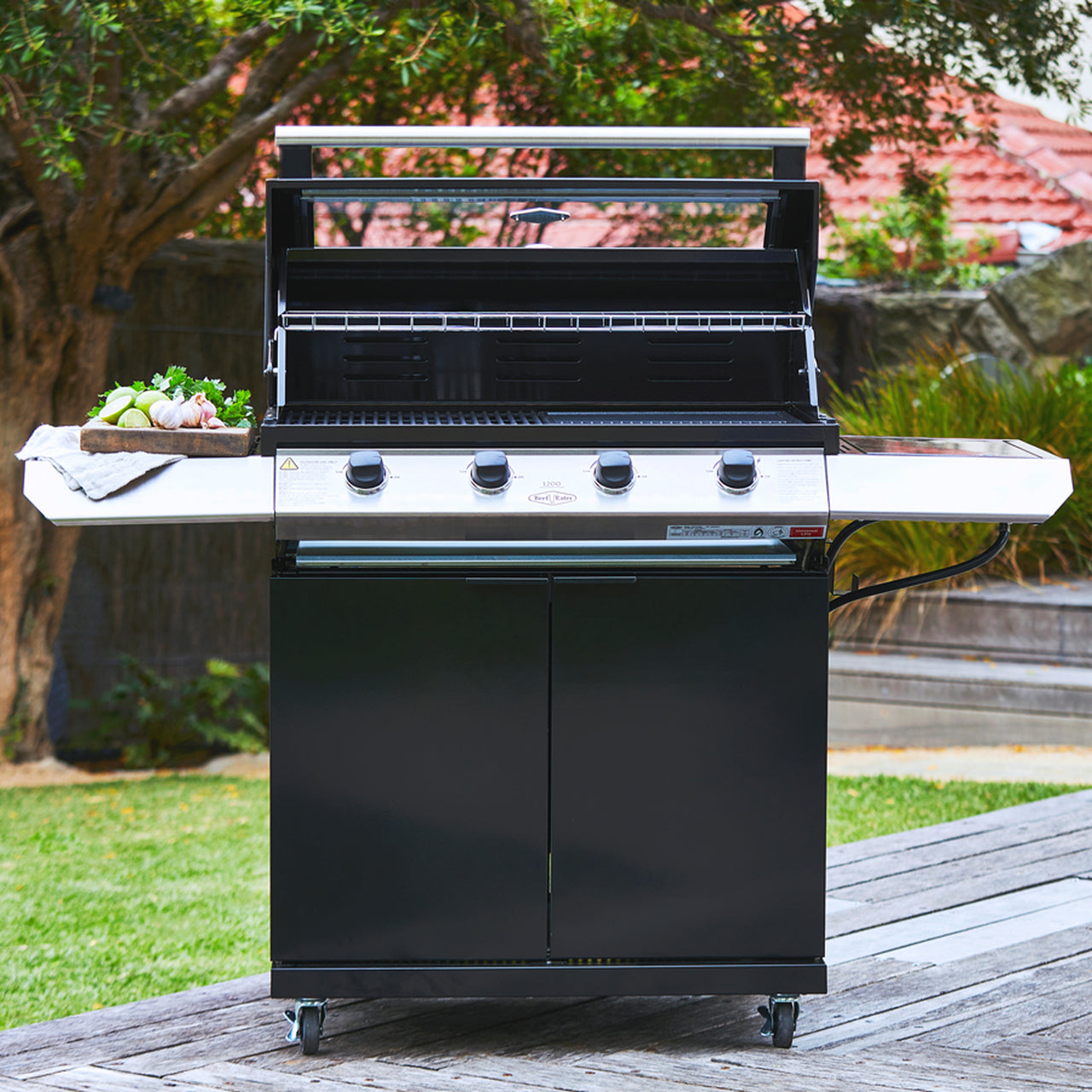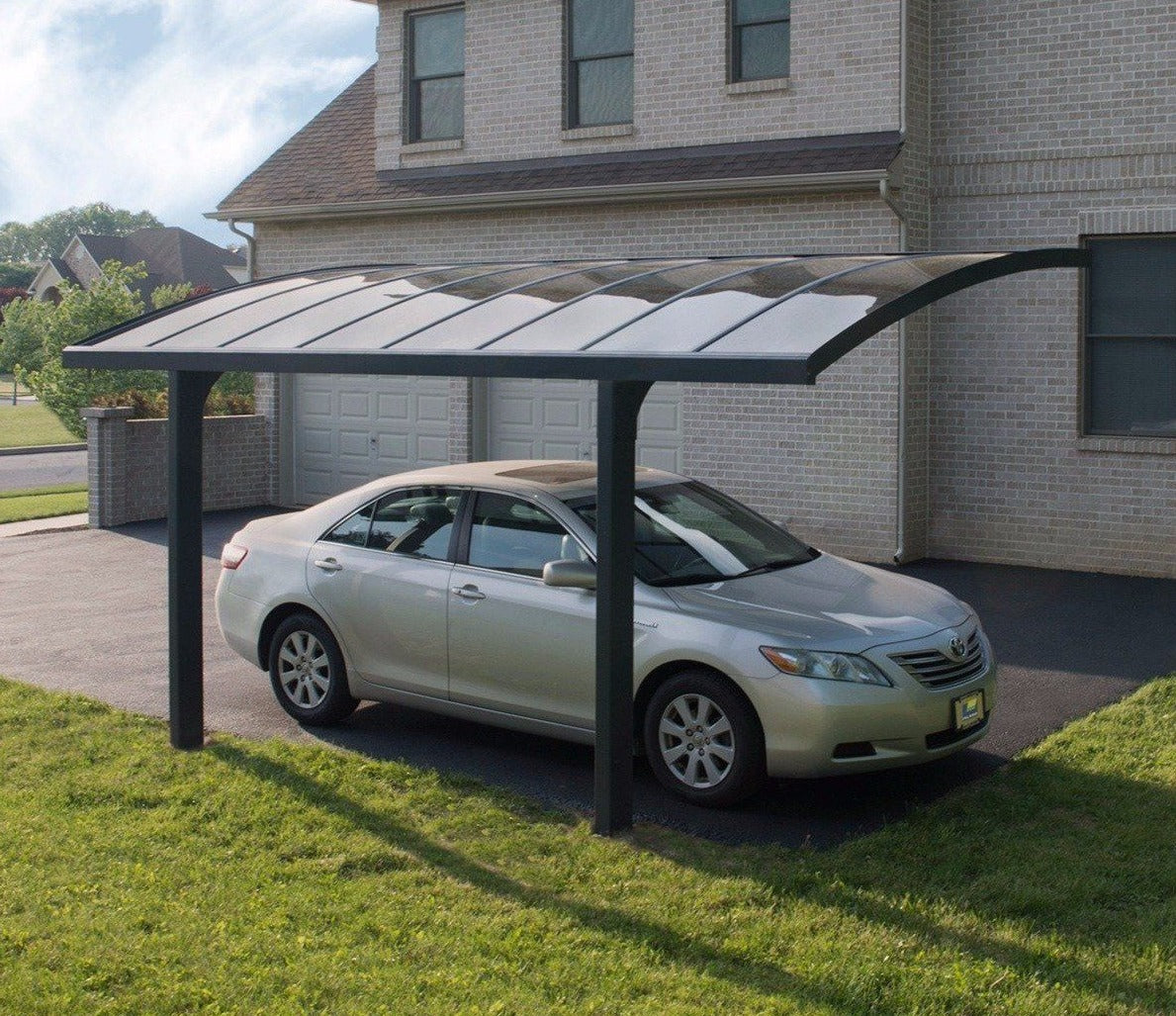5 Brilliant 6x4 Shed Ideas for Small Gardens (Space Saving Solutions)

If you're like most UK homeowners, you've probably stood in your garden and wondered where on earth you're going to store everything. The lawnmower's taking up half the garage, your spades and forks are cluttering the patio, and don't even get me started on where the kids' bikes end up.
Here's the thing, you don't need a massive garden building to sort out your storage chaos. A compact 6x4 shed might just be the perfect answer.
I know what you're thinking. Six foot by four foot doesn't sound like much. But honestly, you'd be surprised how much you can fit into a well-organised small shed. These compact garden buildings are brilliant for typical UK gardens where space is at a premium, and they won't completely dominate your outdoor space.
In this guide, I'm going to walk you through five different approaches to 6x4 sheds and compact alternatives. Whether you're working with a tight budget, looking for something stylish, or need a proper workshop space, there's an option here that'll work for you. The key is choosing the right design for how you actually want to use it.
Why a 6x4 Shed is Perfect for Small Gardens
Let's talk dimensions for a second. A 6x4 shed is roughly 1.8 metres wide by 1.2 metres deep. That's about the same footprint as a small dining table, but obviously taller. Not huge, right? But that's exactly why it works so well.
Most UK gardens aren't sprawling estates. We're talking terraced houses with modest back gardens, semi-detached properties with average sized plots, or even those narrow town gardens where every square metre counts. A 6x4 shed fits into these spaces without making your garden feel cramped or overwhelming the whole area.
The practical benefits are pretty compelling too. You're looking at a significantly lower cost compared to larger sheds, both for the building itself and the groundwork needed. Setting up a base for a 6x4 is far less involved than preparing for a whopping great 10x8. Plus, assembly is genuinely manageable, often a weekend job for two people rather than a major construction project.
Here's something many people don't realise until they check: a 6x4 shed almost certainly won't need planning permission. In most cases, garden buildings under 2.5 metres in height and not taking up more than half your garden fall under permitted development rights. That said, it's always worth a quick check with your local council, especially if you're in a conservation area or your property has special restrictions.
The versatility of a compact shed surprises a lot of folks. You can use it as a straightforward tool store, a potting shed, a bike shelter, or even a small workshop. The trick is thinking vertically, using wall-mounted storage, and being clever about organisation. A smaller footprint doesn't mean compromising on functionality, it just means being a bit smarter about how you use the space.
For garden storage needs, a 6x4 shed handles the essentials beautifully without eating up valuable outdoor space you'd rather use for planting, seating, or letting the kids play.
Idea #1: The Classic Overlap 6x4 Shed for Budget Conscious Gardeners
If you're watching the pennies but still need proper outdoor storage, an overlap construction shed is your friend. This traditional building method has been around for decades because, quite simply, it works.
Overlap cladding is where thin timber boards literally overlap each other, a bit like the tiles on a roof or the feathers on a bird. Each board sits over the one below it, creating a weatherproof barrier that sheds rainwater naturally. It's straightforward, effective, and keeps costs down because it uses less timber than some fancier cladding methods.
The aesthetic is properly rustic, which actually looks lovely in cottage-style gardens or anywhere you want that traditional shed appearance. There's something quite charming about an overlap shed tucked into a corner with climbing roses growing up the side. It feels authentically 'garden shed' in a way that more modern designs sometimes don't.
Now, I'll be honest with you, overlap sheds do need a bit more maintenance than their pricier cousins. The timber arrives with a basic treatment, but you'll want to give it a proper coat of wood preservative once it's up. After that, an annual treatment keeps it in good nick. Think of it like painting a fence, just part of your yearly garden maintenance routine.
The Shire 6x4 Overlap Single Door Value Garden Shed with Side Window is a proper 6x4 option that ticks all the boxes for budget-conscious storage. It's built from slow grown Northern European pine, which is durable stuff that'll stand up to British weather when treated properly.

What I particularly like about this shed is the side window. Natural light makes such a difference when you're rooting around for tools or potting up plants. You're not fumbling about in the dark trying to find your secateurs. The window also provides a bit of ventilation, which is important if you're storing anything that might get a bit whiffy, like compost or fertiliser.
Security wise, it comes with a hasp and staple ready for your padlock. The single door keeps things simple and means more wall space inside for hooks and shelving. At just over 1.8 metres tall, you've got decent headroom too, assuming you're not exceptionally tall.
What to Store in Your Budget 6x4 Shed
Right, so what actually fits in a compact storage shed? You'd be surprised. Here's what works well:
- Garden tools and hand equipment are the obvious starting point. Your spades, forks, rakes, hoes, trowels, and hand tools all find a happy home. Mount a few hooks on the walls and you can hang the long-handled stuff vertically, freeing up floor space.
- Small lawnmowers fit comfortably, whether you've got a traditional push mower or a compact electric model. Just make sure you clean it before storing and you're sorted.
- Plant pots and compost bags are perfect shed fodder. Stack the pots inside each other to save space, and bags of compost sit neatly on the floor or on a low shelf. Having everything in one place makes potting up so much easier.
- Garden chemicals and fertilisers need proper storage away from kids and pets. A 6x4 shed with a window provides the ventilation needed for safe storage, and a good padlock keeps everything secure. Always check the storage instructions on the products themselves, obviously.
The beauty of a straightforward overlap shed is that it does exactly what it says on the tin. It's affordable, functional garden storage that'll last for years with a bit of care.
Idea #2: The Modern Pent Roof Design for Contemporary Gardens
If your garden leans towards contemporary styling, a pent roof shed might be more your speed. The design is sleek, practical, and honestly just looks really smart in modern outdoor spaces.
A pent roof is basically a single-slope roof, like a lean-to but freestanding. One side is higher than the other, creating that distinctive angled roofline. It's a far cry from the traditional apex (pointy) roof you might picture when you think 'garden shed'.
The practical advantages are brilliant. Water runs off efficiently in one direction, so you're not getting drips around the doorway or pooling on a flat roof. This makes pent roof sheds particularly good for positioning against fences or walls, the high side faces out, the low side tucks against your boundary. You get maximum internal height where you need it most, right by the door.
That modern aesthetic really complements contemporary gardens. Clean lines, a minimalist profile, and a design that doesn't scream 'garden shed' in quite the same way as traditional styles. If you've got modern paving, sleek furniture, or architectural planting, a pent roof shed fits right in.
The height advantage inside is worth mentioning. Because of the slope, you've got more headroom on one side, which is perfect for storing taller items or creating a workbench area. You're not stooping quite as much when you walk in.
The Shire 8x6 Pent Flatpack Garden Shed is worth considering. Yes, it's a couple of feet bigger than a true 6x4, but it maintains that compact garden appeal whilst giving you a bit more breathing room.

This one's built with shiplap boards rather than overlap, which means the cladding interlocks tongue and groove style. It's more weatherproof and generally needs less frequent treatment. The timber quality is excellent, slow-grown stuff that's built to last in British weather conditions.
What sets this apart is the build quality. You're getting proper weatherproofing, a well-designed frame, and that contemporary pent style that looks spot-on in modern gardens. The single door and window configuration keeps things simple whilst providing natural light inside.
Positioning Your Pent Roof Shed
Getting the position right makes a huge difference with a pent roof design. Here's what works well:
- Place the high side facing your main viewing point. This shows off the roofline and makes the shed look more substantial. The low side can tuck against a fence or wall.
- Position it where the slope directs water away from paths, patios, or other buildings. You don't want rainwater running off straight onto your decking or towards your house.
- Think about door access relative to your garden layout. You want easy access without having to navigate awkwardly around plants or furniture.
- Use the internal height wisely. Position your workbench or main storage area on the high side where you've got maximum headroom. Taller items like rakes or a stepladder live on that side too.
The neat, organised look of a pent shed really comes into its own when it's positioned thoughtfully. It becomes part of your garden design rather than just something plonked in the corner.
Idea #3: Double Door Sheds for Easy Access
Here's something worth thinking about, sometimes a single door just doesn't cut it. If you're storing bikes, need to get a wheelbarrow in and out regularly, or struggle with narrow doorways, double doors change everything.
The width you gain is significant. A standard single door on a compact shed might be 60-70cm wide. Double doors can give you 120cm or more of clear opening. Suddenly, getting your bike in isn't a three-point turn involving scraped knuckles and muttered swearing.
For families, this is brilliant. Kids' bikes, scooters, outdoor toys, they all get wheeled in and out without drama. Garden furniture that you want to store over winter? Double doors make it actually possible rather than theoretically possible.
There's also an accessibility angle here. If you've got any mobility issues, or if bending and manoeuvring through a narrow space is tricky, wider access just makes life easier. You're not squeezing past the lawnmower to reach the shelf at the back.
The functionality shift is real. You're not just storing stuff, you're actively using the shed as a proper garden workshop or activity space. Double doors let you move larger equipment in and out as needed, whether that's a compact ride-on mower, a workbench you want outside for a project, or bags of paving sand.
The Shire 8x6 Warwick Flatpack Garden Shed shows how double doors work on a compact building. Again, this is slightly larger than a true 6x4, but it demonstrates the double door concept beautifully whilst still being suitable for modest gardens.

What you're getting here is proper shiplap construction for weatherproofing, decent build quality with slow-grown timber, and those generous double doors that make access so much easier. The security features are the same, padlock-friendly fittings that let you secure both doors properly.
Assembly's straightforward too, everything you need comes in the kit with clear instructions. It's still a manageable DIY project, just with the added benefit of not having to squeeze through a narrow doorway once it's built.
What You Can Fit Through Double Doors
Let's get specific about what actually benefits from that wider access:
- Bikes and children's outdoor toys are the obvious winners. Adult bikes, kids' bikes, balance bikes, scooters, they all wheel straight in. No more lifting them over the threshold or angling them through at weird angles.
- Compact ride-on lawnmowers can be stored properly if you've got double doors. Not everyone needs this, but if you've got a slightly larger lawn and use a small sit-on mower, being able to garage it securely is brilliant.
- Garden furniture over winter protects your investment. Stackable chairs, a bistro table, seat cushions, they all come inside without fuss. Your furniture lasts longer and you're not dragging stuff through a narrow gap.
- Wheelbarrows and larger gardening equipment become far less annoying. You can wheel the barrow straight in, load up what you need, and wheel it straight back out. Same goes for garden carts, large planters, or that big bag of bark chips you've just bought.
The practical difference between single and double doors is one of those things you don't appreciate until you've experienced it. It's not essential, but by heck it's convenient.
Idea #4: Workshop-Style Sheds with Windows for Hobbies
Not everyone wants their shed purely for storage. Sometimes you want a space to actually do things, and that's where a workshop-style approach makes sense.
Natural light is absolutely critical if you're using your shed as a hobby space. There's only so much you can achieve with artificial lighting, especially for tasks like potting plants, painting, or detailed DIY work. Good daylight makes everything easier and more pleasant.
Windows provide ventilation too, which matters more than you might think. If you're using wood stains, paints, or varnishes, you need airflow. Same goes for potting compost, which can get a bit musty in a sealed space. A window you can prop open sorts this out nicely.
Creating a multi-purpose garden building from a compact shed is surprisingly achievable. You're not going to fit a full woodworking shop in there, obviously, but for hobbies and lighter workshop activities, a 6x4 or 7x5 footprint works well.
If you're thinking about adding electrics, that's definitely possible but worth getting a qualified electrician involved. A couple of power sockets and a light fitting transform how you can use the space. Just make sure any electrical work complies with regulations and is safe for outdoor use.
The Shire 7x5 Overlap Single Door Value Garden Shed with Double Window shows how windows change the feel of a compact shed. This one's slightly larger than 6x4 but prioritises natural light with two windows, making it brilliant for hobby use.

The double window configuration floods the interior with daylight from two angles. You're not working in shadow, you've got proper illumination for whatever you're doing. The rustic overlap design blends into garden settings beautifully, and the build quality from Northern European pine with a dip-treated base coat gives you durability without breaking the bank.
Hobby Ideas for Your 6x4 Garden Shed
What actually works in a compact garden workshop? Here are some proven uses:
- Potting shed for seedlings and propagation is absolutely brilliant. A small workbench, some shelving for pots and trays, seed storage, and space for your compost and tools. The windows mean you can check on seedlings without opening the door every five minutes.
- Art studio or craft room works surprisingly well. I know a few people who've set up compact sheds for watercolours, pottery, or crafts. Natural light is essential for colour accuracy, and having a dedicated creative space separate from the house is lovely.
- Small workshop for DIY projects handles repairs, model making, or smaller woodworking jobs. You're not building furniture from scratch, but there's room for a workbench, tool storage, and enough space to work on most household repair jobs.
- Garden office for occasional use suits people who need somewhere quiet to work occasionally but don't need a full home office setup. A small desk, a chair, maybe a heater for winter, and you've got a focused workspace.
- Bike maintenance station is perfect if you're into cycling. Hang the bikes on wall hooks, keep your cleaning kit and tools organised, and you've got everything you need in one weatherproof spot.
The key with hobby sheds is setting them up properly from the start. Good lighting, adequate ventilation, and smart storage make all the difference between a space you love using and one that becomes just another storage dumping ground.
Idea #5: Premium Log Cabin Style for Garden Statements
Sometimes you want your garden building to be more than purely functional. If you're looking for something that genuinely enhances your garden aesthetically whilst providing brilliant storage, a log cabin style shed is worth considering.
The construction quality is noticeably different. Instead of thin cladding over a frame, you're getting proper interlocking logs, typically 19mm thick. These slot together like a jigsaw puzzle, creating incredibly sturdy walls that feel more like a small building than a garden shed.
That thicker wall construction provides better insulation, which matters if you're using the space for hobbies or as an occasional workspace. It's warmer in winter, cooler in summer, and just feels more substantial when you're inside.
The aesthetic appeal is undeniable. A log cabin shed looks intentional, like a deliberate garden feature rather than something you've stuck in the corner to hide the lawnmower. The traditional appearance works beautifully in established gardens and can become a focal point rather than something you're trying to camouflage.
Longevity and durability justify the higher investment for many people. A well-built log cabin shed with proper maintenance can last decades. You're not looking at replacing it in five or ten years, this is a proper garden structure.
When to invest in premium quality? If you're staying in your home long-term, if the shed's going to be highly visible, or if you want it for more than basic storage, the extra cost makes sense. It's the difference between a purely functional garden building and one that genuinely adds value to your property.
The Shire 7x7 Bradley Log Cabin Style Shed demonstrates this premium approach. Yes, it's larger than a 6x4, but for smaller gardens where quality and aesthetics are priorities, it's a compact option that delivers on both fronts.
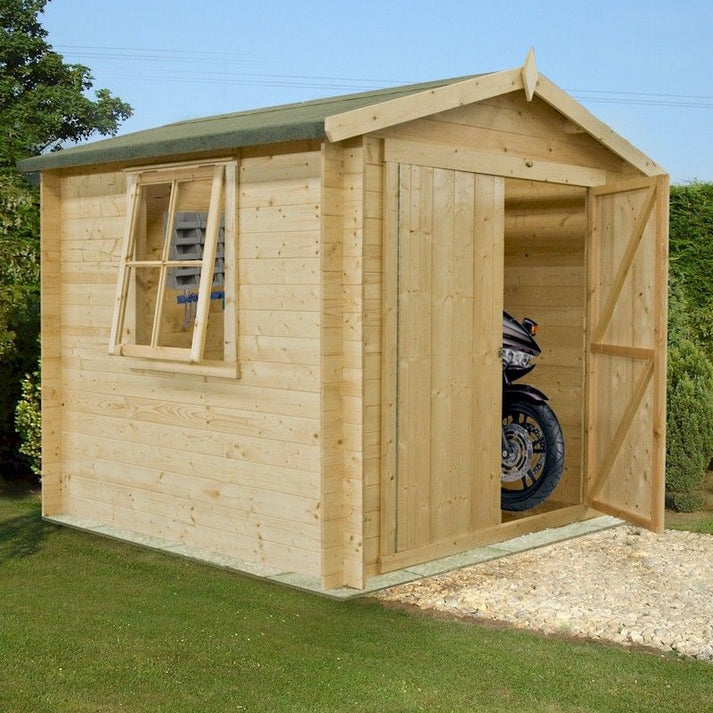
The 19mm interlocking log walls create that authentic cabin feel. The joinery-quality window isn't just functional, it's properly made and looks the part. Fully framed double doors add to the premium feel and provide excellent access. Being UK-made means you're getting construction that understands British weather conditions.
The customisable finish is a real bonus. You can leave it natural and treat it with clear preservative, paint it in a colour that complements your garden scheme, or stain it to match existing woodwork. It becomes truly yours.
Making Your Log Cabin Shed a Garden Feature
If you're investing in a premium shed, position and presentation matter. Here's how to make it look intentional:
- Positioning for maximum visual impact means thinking about sightlines. Where do you look when you're sitting in the garden? Can you see it from the house? Place it where it enhances views rather than cluttering them.
- Surrounding planting ideas soften the structure and integrate it into your garden. Climbers on one side, low planting in front, maybe some height behind to create depth. It becomes part of the landscape rather than sitting on top of it.
- Painting and staining options let you match your garden's colour palette. Subtle greens and greys blend into planting, whilst bolder colours like Farrow & Ball shades create a statement. Just use exterior-grade products designed for garden buildings.
- Adding shelving and organisation inside makes it functional and attractive. Open shelving displays terracotta pots beautifully, hooks keep tools tidy, and everything has its place.
- Creating a destination in your garden is about more than the building itself. A small seating area nearby, good lighting, a path leading to it, these details make it somewhere you want to visit rather than just a storage solution.
A premium log cabin shed treated as a garden feature genuinely adds to your property. It's an investment that pays back in enjoyment and practicality.
Choosing the Right Foundation for Your 6x4 Shed
Right, let's talk about what your shed sits on, because this matters more than most people realise. A proper base is the difference between a shed that lasts twenty years and one that's rotting and wonky after five.
The foundation serves several purposes. It keeps the shed level, which is essential for the door to open and close properly and for the structure to remain sound. It lifts the floor off the ground, preventing damp from soaking into the timber. And it distributes the weight evenly, stopping your shed from sinking into soft ground.
You've got several options, each with different pros and cons:
- Concrete base is the gold standard. It's completely level, incredibly stable, and lasts forever. Pour a concrete pad slightly larger than your shed footprint, and you're sorted. The downside? It's labour-intensive, expensive if you're getting it done professionally, and pretty much permanent. But for longevity, nothing beats it.
- Paving slabs offer a good middle ground. Lay them on a sand and hardcore base, get them properly level, and you've got a solid foundation at a reasonable cost. It's a popular DIY option because it's achievable for most people with basic tools. The key is preparation, you need a properly compacted base underneath or they'll shift over time.
- Shed base kits have become really popular lately. These are usually plastic grids that you lay down and fill with gravel, or pre-formed bearers that create a raised platform. They're quick to install, relatively inexpensive, and work well for smaller sheds. The plastic grid types can feel a bit less solid than concrete or slabs, but they do the job.
- Gravel bases are the budget option. Dig out a shallow area, fill it with compacted hardcore and gravel, and level it off. It's cheap and drains well, but maintaining a level surface long-term can be tricky. Fine for a basic storage shed, but I wouldn't use it for anything more substantial.
Levelling cannot be stressed enough. Even a slight slope will cause problems. Doors won't close properly, rain will pool inside, and the whole structure can gradually rack out of shape. Use a spirit level, take your time, and get it properly flat.
Damp prevention is the other critical factor. Never sit a wooden shed directly on soil. You need an air gap underneath the floor, which is why most shed bases raise the building slightly. This ventilation stops moisture from rotting the floor from underneath.
Quick Base Comparison
-
Concrete Base
- Most durable and stable option
- Expensive and labour-intensive
- Permanent installation
- Best for: Long-term investment, premium sheds
-
Paving Slabs
- Good balance of cost and durability
- Achievable DIY project
- Needs proper preparation underneath
- Best for: Most garden sheds, typical use
-
Shed Base Kit
- Quick and easy installation
- Moderate cost
- Less permanent, can be moved
- Best for: Smaller sheds, renters, temporary setups
-
Gravel Base
- Cheapest option
- Can shift over time
- Good drainage
- Best for: Basic storage, tight budgets
My honest recommendation? For a 6x4 shed that you want to last, go with paving slabs on a properly prepared base. It's the sweet spot of achievable, affordable, and durable.
Essential Accessories for Your 6x4 Shed
Once your shed's up, a few accessories make it significantly more functional and help it last longer. Here's what's actually worth getting:
- Roof felt and weatherproofing should be your first priority. Most sheds come with basic roof covering, but an extra layer of quality roof felt adds years to the lifespan. It's not expensive and only takes a couple of hours to fit. Overlap the sheets properly, fix them securely, and you've dramatically improved weatherproofing.
- Security locks and hasps matter more than people think. The basic hasp and staple that comes with most sheds is fine, but upgrade to a closed-shackle padlock that can't be easily cut. If you're storing expensive equipment or bikes, consider a shed alarm too. They're battery-powered and surprisingly effective as a deterrent.
- Shelving and organisation systems transform how you use the space. Wall-mounted shelves don't take up floor space, pegboards let you hang tools at eye level, and under-bench storage maximises every centimetre. You can buy shed shelving kits or make your own from treated timber offcuts.
- Ventilation options prevent that musty smell and stop condensation problems. Simple air bricks fitted low down and high up create airflow without creating draughts. If your shed doesn't have a window that opens, ventilation becomes even more important.
- Paint and wood treatment protect the timber and let you personalise the appearance. Most sheds arrive with basic treatment, but an annual coat of quality wood preservative keeps them in top condition. If you're painting, use exterior wood paint specifically designed for garden buildings.
- Guttering for rainwater collection serves two purposes. It stops water cascading off the roof and splashing around the base, which helps prevent damp problems. And if you're environmentally minded, you can collect rainwater in a water butt for garden use. Simple guttering kits are inexpensive and easy to fit.
Honestly, spending a hundred quid on accessories can add thousands of hours to your shed's working life. It's worth doing properly from the start.
Planning Permission and Regulations for 6x4 Sheds
Quick legal bit here, but it's important. Most 6x4 sheds don't need planning permission, but you should understand the rules.
In England and Wales, garden buildings are covered by permitted development rights. This means you can build them without planning permission as long as they meet certain criteria. For sheds, the key rules are:
- The building must be no more than 2.5 metres high if it's within 2 metres of your boundary, or 4 metres high elsewhere in your garden. A 6x4 shed is typically around 2 metres high, so you're fine.
- No more than half your garden can be covered by outbuildings. Unless you've got a tiny garden or loads of other buildings, a 6x4 shed won't come close to this limit.
- Distance from boundaries matters for height restrictions. If your shed's going within 2 metres of your property boundary, that 2.5-metre height limit applies.
There are special cases where you might need permission: conservation areas, listed buildings, flats and maisonettes, or if you're planning to use the shed as living accommodation. If any of these apply to you, check with your local planning authority first.
When you might need permission: if your shed faces a highway and is more than 2 metres high, if you're extending a building that's already been extended under permitted development, or if local covenants restrict what you can build.
My advice? If you're unsure, a quick phone call to your local council's planning department clarifies everything. They're usually helpful and it's better to check than to build something you later have to remove.
Building regulations typically don't apply to small garden sheds. They're not habitable buildings, so you don't need to worry about building regs approval. If you're adding electrics, though, Part P of the building regulations covers electrical safety, another reason to use a qualified electrician.
The vast majority of 6x4 sheds fall well within permitted development rights and don't require any permissions. But five minutes checking is worth the peace of mind.
Maintaining Your Garden Shed for Longevity
Right, you've got your shed up and it's looking lovely. Here's how to keep it that way for years.
An annual maintenance checklist keeps you on top of things:
- Wood treatment schedules depend on the product you're using and your shed's exposure. Generally, a coat of wood preservative every year or two keeps the timber protected. If your shed's in full sun or particularly exposed to weather, you might need to treat it annually. Overlap sheds need more frequent treatment than shiplap or log cabin styles.
- Roof maintenance and felt replacement prevents most serious problems. Check the roof felt each spring for any tears, lifting edges, or worn patches. Small repairs are easy with roofing adhesive, but if the felt's generally past its best, replace it. Roof felt typically lasts 5-10 years depending on quality and weather exposure.
- Clearing gutters and drainage should happen at least twice a year, spring and autumn. Blocked gutters overflow and dump water around your shed's base, which is asking for damp problems. It takes five minutes and saves a lot of trouble.
- Checking for rot or damage catches problems early. Look at the base particularly where the shed sits on the foundation. Check around the door frame and window frames where water might get in. Tap wooden panels gently, sound wood sounds solid, rotting wood sounds soft or hollow. Catch rot early and you can treat it, leave it and you're looking at replacement panels.
- Repainting or restaining guidance keeps your shed looking smart and provides protection. If you've painted your shed, you'll probably need to refresh the paint every 3-5 years. Stain tends to last a bit longer but still needs redoing eventually. Preparation is key, clean the wood, sand any rough patches, and apply in dry weather.
- Seasonal preparation tips make a difference:
- Spring: Check for winter damage, clear out any debris, treat the wood if needed, check the roof felt.
- Summer: This is the best time for painting or staining, warm dry weather means products dry properly.
- Autumn: Clear gutters, check drainage, make sure ventilation isn't blocked by fallen leaves.
- Winter: Check after heavy storms, ensure the door still closes properly, clear snow from the roof if you get significant accumulation.
The thing about shed maintenance is that little and often beats doing nothing for years and then facing a massive job. An hour or two each spring keeps everything in good order.
Finding the Perfect 6x4 Shed for Your Garden
So there you have it, five different approaches to compact garden sheds that actually work in real UK gardens.
I know some of these are bigger than 6x4 but it's important to see what an extra foot can provide you.
Shop our 6x4 Sheds Here!
And our Small Garden Sheds Here!
Whether you've gone for the budget-friendly overlap option, fallen for the clean lines of a pent roof design, decided double doors are essential, chosen a window-filled workshop space, or treated yourself to a premium log cabin, you're sorted for outdoor storage.
The beauty of a 6x4 shed or similarly compact garden building is that it solves your storage problems without dominating your outdoor space. You're not sacrificing half your garden to house a lawnmower, you're adding a practical building that earns its footprint.
Think about how you'll actually use the space. Pure storage? Go for something straightforward and weather-resistant. Hobby use? Prioritise windows and ventilation. Want it to look good? Consider the aesthetic carefully and position it well. Need regular access for bikes or furniture? Double doors change everything.
Quality construction genuinely matters. Cheap sheds fall apart, leak, and need replacing within a few years. Invest in decent timber, proper weatherproofing, and solid construction, and you're looking at decades of use. It's worth getting it right first time.
The options we've covered show there's genuinely a shed style for every need and budget. From affordable overlap construction right through to premium log cabin quality, you can find something that works for your specific situation.
Take your time choosing, prepare the base properly, and maintain it with a bit of regular care. Your 6x4 garden shed will serve you brilliantly for years to come, keeping your tools dry, your garden tidy, and giving you back that space currently cluttered with outdoor equipment.
Whatever you decide, you're making a smart investment in your garden and your home. Good storage sorts out so many everyday frustrations, and there's something really satisfying about having everything organised and in its place.








